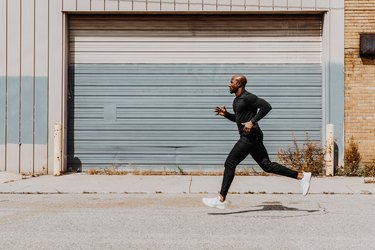
Is it bad to only be able to hold your breath for 30 seconds? What about 45 seconds or a minute?
Lots of things can affect your ability to hang on to a big gulp of air, and it's normal for different people to be able to hold their breath for different lengths of time.
Video of the Day
Video of the Day
Here's what's typical, plus what you can do to boost your lung capacity and hold your breath for longer.
What's the Average Time to Hold Breath?
Different people can hold their breath for different amounts of time. "Most people can hold their breath for 30 to 90 seconds without any difficulty," says registered respiratory therapist Mandy De Vries, MS-RCL/Ed, director of education at the American Association for Respiratory Care (AARC).
However, that time can vary based on a number of factors.
What's the World Record for Holding Breath?
In March 2021, a Croatian man named Budimir Šobat held his breath for 24 minutes and 37.36 seconds, according to Guinness World Records, surpassing the previous world record by 34 seconds.
Factors That Affect How Long You Can Hold Your Breath
1. Lung Health
You may not be able to hold your breath for that long if you smoke or have an underlying medical condition. For example, people with chronic obstructive pulmonary disease (COPD) or asthma usually can't hold their breath as long.
Infections like COVID-19 can factor in too. Even mild cases can cause temporary shortness of breath, while more severe ones can lead to permanent lung scarring that may reduce your lung capacity, according to Johns Hopkins Medicine.
2. Physical Fitness
People who regularly engage in aerobic exercise, especially activities like swimming and running, tend to have greater lung volumes that makes it easier to hold their breath for longer, De Vries explains.
3. Body Size and Shape
Taller people tend to have greater lung capacities compared to those who are shorter.
Carrying excess abdominal fat, on the other hand, can reduce your lung volume by compressing your chest wall, according to a February 2017 paper in Multidisciplinary Respiratory Medicine.
Lung volume can even (temporarily) shrink during pregnancy, as a person's expanding uterus can put extra pressure on the lungs.
4. Age
Finally, don't discount age. Starting at age 35, our lung volume and pulmonary function start to slowly decrease, per the Multidisciplinary Respiratory Medicine paper. So younger adults may be able to hold their breath longer than older adults.
The Benefits of Greater Lung Capacity
The lungs are responsible for taking in oxygen and removing carbon dioxide from the blood. So when your lung capacity is healthy, you'll experience healthier physical function and feel your best overall.
You may also be less prone to breathing issues. "People with greater lung capacity tend to have lower rates of respiratory problems, such as asthma and bronchitis," says De Vries.
Being able to take in more oxygen can improve your exercise performance, too, especially when it comes to endurance activities like running or swimming. So you'll be able to push yourself longer and harder and need less time to recover, De Vries says.
How to Increase Your Lung Capacity and Hold Your Breath Longer
Anyone can boost their lung capacity. How you go about doing it depends on your current fitness level and overall health.
Whether you're looking to take your workouts to the next level or just make everyday activities like walking or stair-climbing a little easier, here's what to do.
1. Prioritize Aerobic Exercise
Aerobic activities force your heart and lungs to work harder to supply your muscles with more oxygen. When done consistently, your cardiovascular system becomes more efficient at delivering oxygen to your muscles, so you're less likely to feel out of breath, according to the American Lung Association (ALA).
Exercises that involve deep breathing, like running or swimming, are the most effective for increasing lung capacity, De Vries says. "Interval training, which alternates periods of high-intensity activity with periods of rest, has been shown to be particularly beneficial," she adds. (This 20-minute HIIT workout will give you a big aerobic bang for your buck.)
That said, you don't have to go full throttle to reap the benefits of aerobic exercise. Even walking can make a difference, as long as you maintain a pace where you're moderately breathless (you should be able to talk but not sing).
Warning
Always make sure to check with your doctor before starting a new exercise program, especially if you're new to physical activity or have a long-term lung condition.
2. Practice Breath-Holding Training
Breath-holding training involves gradually increasing the amount of time you can hold your breath. "It has been shown to be an effective method for increasing lung capacity," De Vries says.
Best of all, it's easy to do — follow these steps:
- Sitting up straight, open your mouth and inhale as deeply as possible.
- Then close your lips and hold your breath for as long as you can, keeping track of the seconds with a watch or your phone.
- Repeat the process, gradually working to hold your breath for a few more seconds each time. (But stop if you feel dizzy or faint.)
3. Try Pursed Lip Breathing
Pursed lip breathing, which reduces the number of breaths you take to keep your airways open longer, is a common exercise used to help people with long-term lung conditions like COPD or emphysema improve lung capacity, per the ALA. (Other healthy habits can help you breathe easier with these conditions, too.)
To try it, inhale through your nose and exhale for twice as long through your mouth while keeping your lips pursed. (If you inhale to the count of two, for instance, you'd exhale to the count of four.) Repeat several times.
4. Take Deep Belly Breaths
Like pursed lip breathing, belly breathing can be used to increase your lung capacity, the ALA says. (It's a good stress-buster, too.) Here's how:
- Inhale through your nose while placing your hands on your stomach, so you can feel your belly rising and falling. Keep your neck and shoulders relaxed.
- Exhale through your mouth for two to three times as long as you inhaled. (If you inhale to the count of two, for instance, you'd exhale to the count of four to six.)
- Repeat several times.
5. See a Respiratory Therapist
If your breathing problems are making it harder to carry out everyday activities, talk with your doctor about seeing a respiratory therapist.
"They can provide treatments that can help improve airflow and lung function," De Vries says. "They can also teach you how to properly use inhaled medications and manage your condition."
That in turn can help you breathe easier and increase your activity level — and improve your overall quality of life.
Is this an emergency? If you are experiencing serious medical symptoms, please see the National Library of Medicine’s list of signs you need emergency medical attention or call 911.


